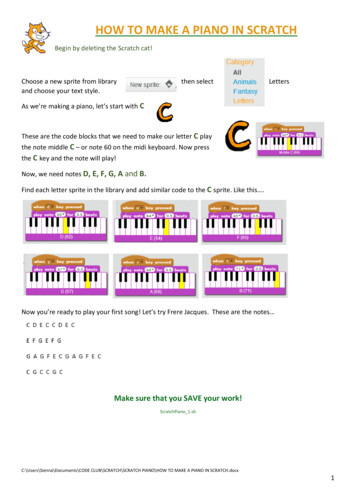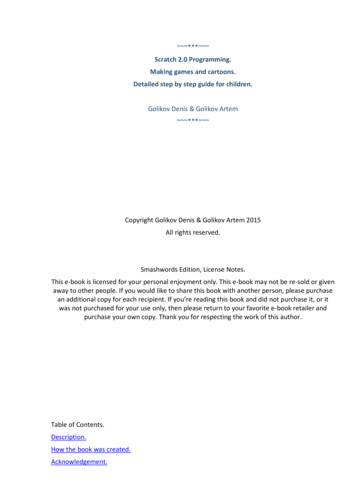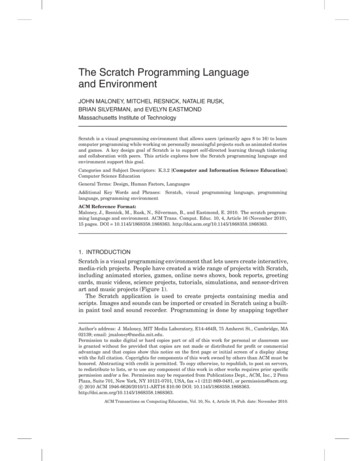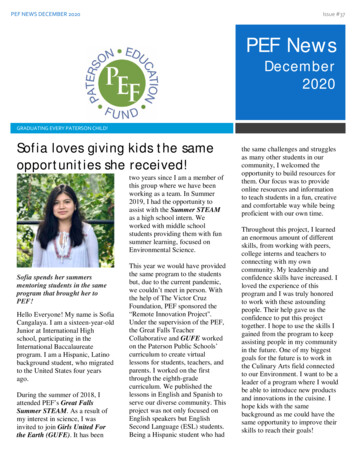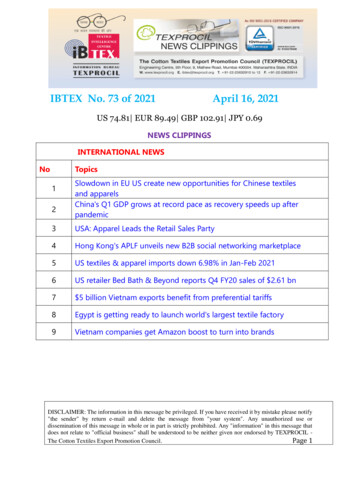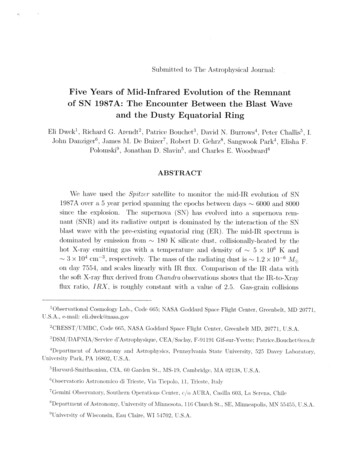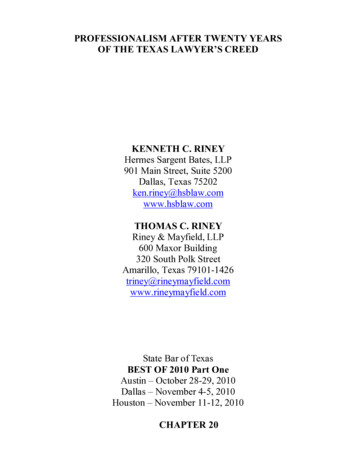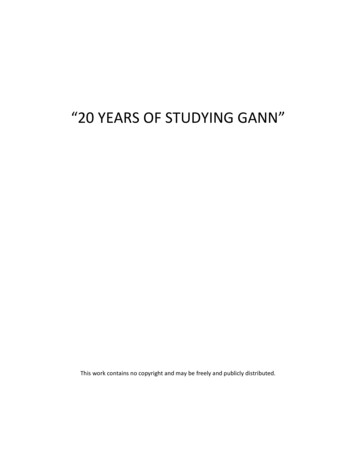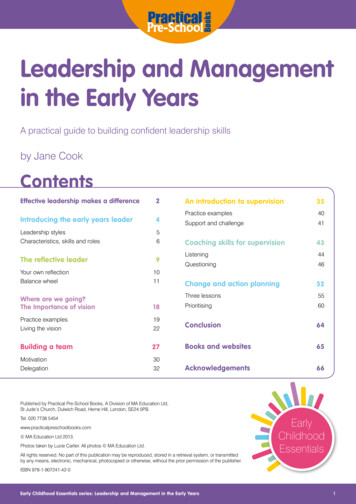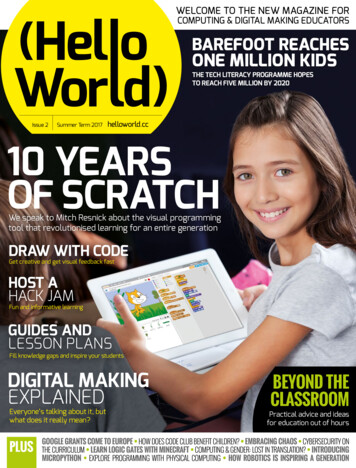
Transcription
WELCOME TO THE NEW MAGAZINE FORCOMPUTING & DIGITAL MAKING EDUCATORSBAREFOOT REACHESONE MILLION KIDSTHE TECH LITERACY PROGRAMME HOPESTO REACH FIVE MILLION BY 2020Issue 2Summer Term 2017helloworld.cc10 YEARSOF SCRATCHWe speak to Mitch Resnick about the visual programmingtool that revolutionised learning for an entire generationDRAW WITH CODEGet creative and get visual feedback fastHOST AHACK JAMFun and informative learningGUIDES ANDLESSON PLANSFill knowledge gaps and inspire your studentsDIGITAL MAKINGEXPLAINEDEveryone’s talking about it, butwhat does it really mean?Practical advice and ideasfor education out of hoursGOOGLE GRANTS COME TO EUROPE HOW DOES CODE CLUB BENEFIT CHILDREN? EMBRACING CHAOS CYBERSECURITY ONTHE CURRICULUM LEARN LOGIC GATES WITH MINECRAFT COMPUTING & GENDER: LOST IN TRANSLATION? INTRODUCING(helloworld.cc)MICROPYTHON EXPLORE PROGRAMMING WITH PHYSICAL COMPUTING HOW ROBOTICS IS INSPIRING A GENERATIONPLUS1BEYOND THECLASSROOM
FEATURESCRATCH:THE FIRST TEN YEARSThe educational programming language celebrates its tenth anniversaryn 15 May 2007, a revolutionaryprogramming tool was made freelyavailable to the public. Developed by MIT’sMedia Lab, Scratch (scratch.mit.edu)featured a unique graphical interface thatallowed programs to be assembled likebuilding blocks, making it accessible tonew coders of all ages. Since then, Scratchhas gone through several iterations andexperienced exponential growth in thenumber of users, becoming a mainstay inclassrooms and after-school code clubsaround the world. To celebrate its tenthanniversary, we chatted to Scratch Teamleader Mitchel Resnick, Papert Professor ofLearning Research at the MIT Media Lab.Mitchel tells us that he and his teamwere inspired to start work on Scratchback in 2003 when working withyoungsters in Computer Clubhouseafter‑school learning centres. “We sawthat many of them wanted to createtheir own interactive stories, games, andanimations, but there weren’t good tools.So we produced Scratch to enable themto do it.” He adds, “The fact that you canmake a wide diversity of projects is animportant part of its appeal.”Mitchel says that Scratch was built upona lot of lessons learnt over the years. “Iworked closely with Seymour Papert, thedeveloper of Logo, the first programminglanguage for kids. So the work was veryinspired by Seymour’s ideas and his workon Logo, as well as other things that hadbeen done in the field.”O22helloworld.cc
“THE FACT THAT YOU CAN MAKEA WIDE DIVERSITY OF PROJECTS ISAN IMPORTANT PART OF ITS APPEALhelloworld.cc23
FEATUREScratch mapScratch users across the world. Countries shadedin darker colours have a higher number of Scratchusers, with the darkest shade representing theUSA’s eight million users.Collaborative codingWhile Mitchel says that the team alwayshad high hopes that Scratch wouldeventually become something commonlyused by young people around the world,“we continue to be surprised, delighted,and amazed at the wide range of ways thekids make use of it, particularly in relationto the online community: kids aren’t justcreating things of their own, but are findingall different ways of collaborating andsharing. You’ll often hear kids say, theycame to make a project but they stayed forthe community.”24helloworld.ccThis collaborative aspect was given amajor boost by the arrival of Scratch 2.0 inMay 2013, with the addition of an onlinecode editor to the Scratch website. Thisalso made it possible to instantly see thecode inside other users’ projects and ‘remix’them. Previously, users would need to do alltheir programming in an offline code editorbefore uploading projects to the website.“I do think our second version of Scratchmade it much more seamless to go betweenauthoring and the community.”Following the launch of Scratch 2.0, therewas a huge jump in the monthly number ofnew projects and users, an upward trendthat has continued ever since, resulting in atotal of more than 18 million users and 22million projects shared at the time of writing.Mitchel attributes some of its success tothe general culture becoming much moreinterested in coding over the last fewyears, although he notes that Scratch alsoprobably contributed to that: “One of thereasons the culture became interested incoding was because of Scratch.”Mitchel reveals that he is amazed bysome of the Scratch projects created byusers. “One of the things that makes it so
IN NUMBERSexciting and rewarding to work on is thatwe are constantly surprised by what theydo. A few weeks ago, there was a ten-yearold [autistic child] who did a project talkingabout the challenges of being autisticand trying to explain why it’s OK to bedifferent. So the fact [Scratch] gave kids theopportunity to express themselves that wayis really, really important.”Mitchel is also impressed by a lot ofthe collaboration that goes on betweenScratch users. “There is a young womanin South Africa who did this project called‘The Colour Divide’ (v), influenced by herupbringing and the scars of apartheid.It’s a story of a fantasy world where peopleare assigned one colour or another. Butit’s not that she had this idea which wasdeep with meaning – she then led a wholeteam of people working on it together.Some are doing the voices, some doing theillustrations, some developing the music a whole international team of kids.”Code to learnScratch is used in many schools tointroduce children to coding, and Mitchelbelieves that learning to code is anessential part of education. “I do like tomake the analogy of learning to write. Wedon’t have people learn to write becauseeveryone’s going to grow up to become aprofessional journalist or novelist It’s a wayof communicating with other people and away of expressing your ideas. Also, as youwrite, you organise your ideas. I think wesee the same thing with coding.”While Mitchel notes that lots of good jobswill be available for those able to program,learning to code has other benefits. “The actof coding helps you reason systematically:you have to think in a logical way in orderhelloworld.cc25
FEATURESimple but powerfulThe design team has always strived to makeScratch simple for beginners to learn, while offeringpowerful functionality for advanced users. Mitchelsays, “My mentor Seymour Papert used to talk abouta ‘low floor and high ceiling’: it should be easier toget started, but do more advanced things over time.We also talk about ‘wide walls’: the many pathwaysof getting started.”Most importantly, Mitchel insists thatScratch is for everyone: “All different ages, alldifferent backgrounds, all different interests,all different cultures.”to create the programs. For us, it’s just asimportant, if not more important, for kids todevelop their voice, to express their ideas.”While he appreciates that the teachingof computing may have improved inrecent years, “my critique is that a lotof the computer science classes are toofocused on learning a set of computerscience concepts.” While he notes thatthis is useful, “They generally don’t focuson the ability to express yourself with thecomputer. And for me, that’s an importantelement that’s often left out.”He asserts that one of the mostimportant aspects of learning to code isgoing through the creative design process.n Alongside Python, Scratch is one of the mainprogramming languages used in Code ClubsSCRATCHTIMELINEKEY EVENTS INTHE HISTORYOF SCRATCH26helloworld.ccn The current release, Scratch 2.0, features online code editingand project sharing“For me, it’s very important to do thingsin a project-based way. We learn how tostart an idea, and carry it through on aproject. That’s important for everybody– it’s not just about computer science.Computers open up the possibility for kidsto work on a much wider array of projectsand learn the creative design process in abetter way.”Asked whether computing lessons canhelp engage pupils who are otherwise notthat interested in school, Mitchel replies,“It all depends on how it’s introducedand used, because there’s a risk thatcomputers and coding can be introducedin a way that turns off kids: if you’re justgiving them problems to solve, they’remade to feel inadequate because they getthe wrong answer. On the other hand,if it’s introduced in a way where kidswork on projects that they care about, incollaboration with others, then I think itcan be really motivating.“We want to develop technologiesand activities based on what I call the20035 MAY 200715 MAY 200726 MAY 2007Kindergarten Group atScratch project, Weekendversions, Scratch 1.0 and thefeaturing updated Controlthe MIT Media Lab starts(helloworld.cc/2pdZ0um)Scratch website are madeblocks and other tweakswork on developing a newis uploadedpublicly availableMitchel Resnick’s Lifelongprogramming languageThe oldest existingFollowing various betaScratch 1.1 is launched,
four Ps of creative learning: projects,passion, peers, and play. If we introduceit in the right way, then it can helpkids develop as creative thinkers, and Ithink there’s nothing more important intoday’s society.”The future of ScratchThe next stage in the Scratch story isversion 3.0, currently in development,although a public release date is still someway off. Mitchel reveals that one key areaof improvement will be with regard tophysical computing. “We’re designing itto be much easier for people to connectexternal hardware. We talk about tryingto meet kids where they are, to be part of[their] lives. So to connect to the physicalworld is part of that.”He notes that kids also live in the onlineworld, “so we want to make it easier toconnect Scratch to online services anddata sources. So if I make a Scratchproject with a weather map, I should beable to pull in the latest weather data.“improve the experience for newcomers.To this end, Scratch 3.0 will feature bothvertical and horizontal block placement.“We’re planning to have a couple ofdifferent ‘grammars’. In Scratch Jr [a mobilen The Scratch website made its public debut on 15 May 2007; projectscould be played but not edited directlyTHE ACT OF CODING HELPS YOU REASONSYSTEMATICALLY: YOU HAVE TO THINKIN A LOGICAL WAYOr, if I wanted to get a song for a Scratchproject, from within Scratch I should beable to go to Spotify and pull in a musicclip.” Users will also be able to connect toexternal online services for functionalitysuch as speech recognition.Mitchel admits, “Scratch has not donesuch a great job of supporting use onmobile devices, so that’s something we’repaying a lot more attention to now.” Headds that the team is always looking toversion of Scratch aimed at younger kids],we used horizontal blocks, partly becauseinstead of words we use icons.”As for what the next ten years mayhold for Scratch, Mitchel says, “My hopesare that it does become more of a typeof literacy, an extended form of writingthat lets you create all sorts of things. Soit’ll be part of the creative toolkit that kidsgrow up with, for when they want to makesomething dynamic and interactive.”n Scratch Team leader Mitchel Resnick is the Papert Professor ofLearning Research at the MIT Media Lab2 DEC 20072 SEP 20086 DEC 20082 JUL 20099 MAY 2013new blocks and improvementsfeatures such as listsevent takes place at MIT1.4 has a revamped UI andpublic: it features a redesignedmany new featureseditor and website, and allowsScratch 1.2 features severalScratch 1.3 includes newThe first annual Scratch DayThe last 1.x release, ScratchScratch 2.0 is released to theyou to edit projects directlyfrom your web browserhelloworld.cc27
connect Scratch to online services and data sources. So if I make a Scratch project with a weather map, I should be able to pull in the latest weather data. Or, if I wanted to get a song for a Scratch project, from within Scratch I should be able to go to Spotify and pul
